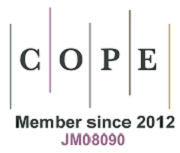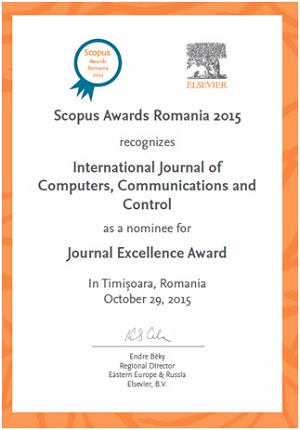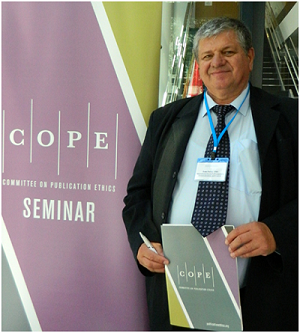Fuzzy and Neural Controllers for a Pneumatic Actuator
Keywords:
fuzzy control, neural control, force-position feedback, pneumatic actuatorAbstract
There is a great diversity of ways to use fuzzy inference in robot control systems, either in the place where it is applied in the control scheme or in the form or type of inference algorithms used. On the other hand, artificial neural networks ability to simulate nonlinear systems is used in different researches in order to develop automated control systems of industrial processes. In these applications of neural networks, there are two important steps: system identification (development of neural process model) and development of control (definition of neural control structure). In this paper we present some modelling applications, which uses fuzzy and neural controllers, developed on a pneumatic actuator containing a force and a position sensor, which can be used for robotic grinding operations. Following the simulation one of the algorithms was tested on an experimental setup. The paper also presents the development of a NARMA-L2 neural controller for a pneumatic actuator using position feedback. The structure had been trained and validated, obtaining good results.References
Amann P., Perronne J.,M., Gissinger G.,L., Frank P., M., Identification of fuzzy relational models for fault detection, Control Engineering Practice 9, 555, 2001. http://dx.doi.org/10.1016/S0967-0661(01)00016-8
Emami M.R., Goldenberg A.A., Burhan T.R., Systematic design and analysis of fuzzy-logic control and application to robotics, Part I. Modeling, Robotics and Autonomous Systems 33, pp. 65-88, 2000. http://dx.doi.org/10.1016/S0921-8890(00)00080-4
Jang, R., MATLAB - Fuzzy Toolbox - The MathWorks, Inc. Revision: 1.12, Date: 2000, 15.
Novakovic, B., Scap, D., Novakovic D., An analytic approach to fuzzy robot control synthesis, Engineering Applications of Artificial Intelligence 13, pp. 71-83, 2000. http://dx.doi.org/10.1016/S0952-1976(99)00044-5
Preitl, St., Precup, E., Introducerea în conducerea fuzzy a proceselor, Ed. Tehnicã, Bucuresti, 1997.
Reznik L., Ghanayem O., Bourmistrov A., PID plus fuzzy controller structures as a design base for industrial applications, Engineering Applications of Artificial Intelligence 13, pp. 419-430, 2000. http://dx.doi.org/10.1016/S0952-1976(00)00013-0
Vesselenyi T., Automated flexible cell for microstructure recognition, PhD Thesis, Universitatea "Politehnica" Timisoara, 2005.
M.M., Chen, J.A., Fairwather, S.A., Green, EDUMECH. Mechatronic Instructional Systems. Case Study: Pneumatics Systems, Production of Shandor Motion Systems, Inc., 1999.
Harbick K., Sukhatme S., Speed Control of a Pneumatic Monopod using a Neural Network, www.harbick-ann.com, 2002.
Raad R., Raad I., Neuro-Fuzzy Admission Control in Cellular Networks. Communication systems, (10th IEEE Singapore International Conference on Communication systems.), pp. 1-7, 2006.
Wenmei H., Yong Y., Yali T., Adaptive neuron control based on predictive model in pneumatic servo system, 2002.
Zuo X.Q., Fan Y.S., A chaos search immune algorithm with its application to neuro-fuzzy controller design. Chaos, Solitons & Fractals, Vol. 30, Issue 1, pp. 94-109, 2006. http://dx.doi.org/10.1016/j.chaos.2005.08.126
Zhang J., Knoll A., Schmidt R., A neuro-fuzzy control model for fine-positioning of manipulators, Robotics and Autonomous Systems, 32, pp. 101-113, 2000. http://dx.doi.org/10.1016/S0921-8890(99)00112-8
Published
Issue
Section
License
ONLINE OPEN ACCES: Acces to full text of each article and each issue are allowed for free in respect of Attribution-NonCommercial 4.0 International (CC BY-NC 4.0.
You are free to:
-Share: copy and redistribute the material in any medium or format;
-Adapt: remix, transform, and build upon the material.
The licensor cannot revoke these freedoms as long as you follow the license terms.
DISCLAIMER: The author(s) of each article appearing in International Journal of Computers Communications & Control is/are solely responsible for the content thereof; the publication of an article shall not constitute or be deemed to constitute any representation by the Editors or Agora University Press that the data presented therein are original, correct or sufficient to support the conclusions reached or that the experiment design or methodology is adequate.







